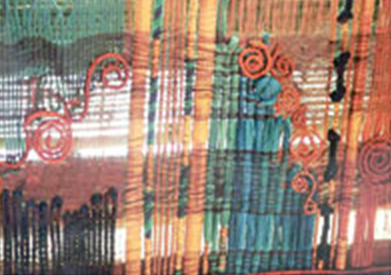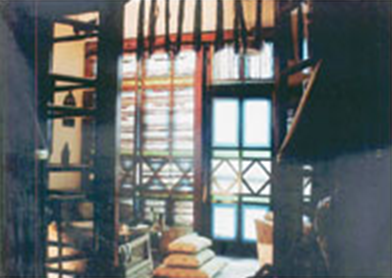Sonia Murad, textile artist
This is a collection of articles archived for the excellence of their content. Readers will be able to edit existing articles and post new articles directly |
Sonia Murad, textile artist
Straight from the loom
By Salwat Ali
Using indigenous craft to produce contemporary art, Lahore based textile artist Sonia Murad innovates on the loom as well as off it. As painters express through brush and paint on canvas so she negotiates the warp and the weft on the ‘khaddi’ and through hand weave. Her ‘Art on windows’ is an interesting amalgam of abstraction, Art Deco stylization and oriental geometric pattern in a woven and stitched format.
A 1995 NCA graduate Sonia recalls that theirs was the first batch from the Department of Textile Design that was allowed to produce thesis projects in textiles as an art form. Formerly requirements were related to traditional lines of home textiles only. This liberty to experiment became the basis of Murad’s creative endeavours. Adhering to her ethos of “I want to dream of everything” she designed a thesis presentation related to windows and ceilings entirely in weave, intentionally choosing a direct translation of her thoughts on the loom, with no prior design sketches detailing her format. This spontaneous interpretation of ideas places her alongside abstract artists for whom art is a sensory experience and not a pre planned activity. It is this abstractionist approach that has enabled her to twist and redefine an ordinary, rigidly linear and conventional product like a bamboo chickh blind into an aesthetic object. While it is derigeur today to indulge in mixed media craft / art arrangements it was less so a decade ago. Sonia Murad is among the first to experiment with the traditional chickh as an art exercise in the mid 90s. She still recalls the rejections and refusals her early productions encountered. Prospective clients and customers were uneasy about hanging her innovations and galleries had no arrangements for the display of art of this nature. But persistence paid its own dividends. Presently, eleven years down the line Murad has established her ‘Art on windows’ and if fine artists accrue mileage through exhibition of their work in galleries so Murad has accomplished through her art in use (and private display) within domestic interiors of countless clients
Fusing traditional form and modern aesthetic sensibility the humble bamboo chickh is reinvented as a trendy home furnishing product
As a visual artist, source of light is one of the major considerations that dictate her sense of design. Many of her designer blinds are projected to advantage because of the imaginative play of light filtering through the semi transparent shades. The other novelty is the incorporation of non traditional materials like glinting metallic copper wire, beads, buttons, rings, bells and any trinkets and hand crafted accessories that take her fancy, in a free form arrangement. Her inspiration is nature especially the chromatically exciting intricacies found in flora and fauna, even entymological specimens, in her surroundings. In addition to hand loom bamboo chickh, her off loom products, include copper wire chickh which are entirely hand woven without a frame, wooden chickh composed of slats of wood, machine stitched fabric blinds, roll up blinds, tie back curtains and roman blinds. Other than woven compositions she also mixes traditional hand embroideries and border patterns into her work and designs appliqué and cutwork patterns on her fabric blinds a per the home / office décor requirements.
With a considerable number of commissioned works behind her Murad expanded her existing repertoire with the concept of ‘Design surrounds windows.” This gave her the opportunity to place her handiworks in a coordinated setting by making novel use of redesigned, primitive silver jewellery, wrought iron fixtures, ceramic tiles and carved wooden attachments for decorative hanging rods, holders and other accessories. As an NCA graduate she has working experience of all the fundamental processes related to fine arts e.g. fiber art, printmaking, photography, ceramics, glass painting etc. and thus furniture design as an extension of her chickh décor also evolved naturally.
She has designed chairs, tables with elaborate tops, lamps, mirrors and wall hangings in wood, glass, ceramics, metal and fiberglass and is often asked to assist clients with selection of suitable upholstery and other furnishings to complements the art objects.. The artist works from her own studio-cum-workshop where she has a set of workers who work along with her. Since there is no mass production of her ideas, each project demands a new concept and she literally works in ‘a hands on manner’ with her assistants to ensure proper implementation of her ideas.
Sonia Murads fascination for textile art stems from her childhood home environment as well as her association with NCA. She grew up in an atmosphere where there was much artistic use of needle craft and stitchery. Her mother had a distinct aesthetic bent realized through home décor, craft painting and finely tailored fabric, which was passed on to her progeny in meticulous detail. Murad opines that till then her knowledge of textile art was just related to fabric and needlework. Her entry into NCA was the defining moment when the artist in her became aware of the larger aspect of art and she eventually opted for textile as an art expression. Her woven, stitched, embroidered and cutwork imagery maybe tailored for commissioned projects but her clients give her freedom of expression and she is able to conjure exotic Art Deco symbols, arabesques and exaggerated organic forms in a vibrant palette of earthy hues.
The emergence of such artists who merge art and craft and produce an intermediate body of work, not wholly fine art or completely a craft job is a new and growing phenomenon now. With interdisciplinary crossovers like these a middle corridor has come into being where craft is being incorporated into the art experience. The end product is an art object with a decorative and utilitarian purpose. Formerly such produce was given short shrift but appreciation levels are changing with the growth of new media arts as this also addresses the current art theories of fusion and amalgamation within the arts. But most of all this merger gives a shot in the arm to a dying craft tradition by infusing it with a contemporary spirit.




